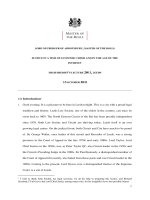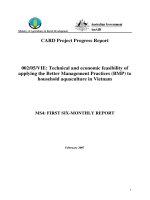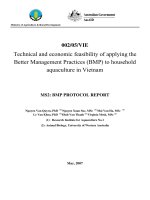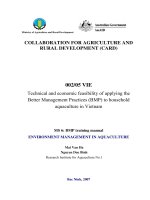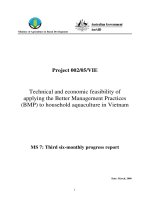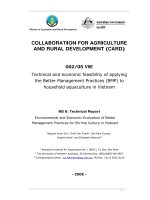ECONOMIC FEASIBILITY OF UTILIZING SALINE GROUNDWATER IN a RECIRCULATING AQUACULTURE SYSTEM
Bạn đang xem bản rút gọn của tài liệu. Xem và tải ngay bản đầy đủ của tài liệu tại đây (677.01 KB, 66 trang )
ECONOMIC FEASIBILITY OF UTILIZING SALINE GROUNDWATER OF WEST
ALABAMA TO PRODUCE FLORIDA POMPANO IN A RECIRCULATING
AQUACULTURE SYSTEM
Except where reference is made to the work of others, the work described in this thesis
is my own or was done in collaboration with my advisory committee. This thesis does
not include proprietary or classified information.
____________________
Jacob Gorman
Certificate of Approval:
_____________________
Norbert L. Wilson
Associate Professor
Agricultural Economics &
Rural Sociology
_____________________
John L. Adrian, Chair
Professor
Agricultural Economics &
Rural Sociology
_____________________
Deacue Fields
Associate Professor
Agricultural Economics &
Rural Sociology
_____________________
Jesse A. Chappell
Associate Professor
Fisheries & Allied
Aquacultures
_____________________
George T. Flowers
Dean
Graduate School
ECONOMIC FEASIBILITY OF UTILIZING SALINE GROUNDWATER OF WEST
ALABAMA TO PRODUCE FLORIDA POMPANO IN A RECIRCULATING
AQUACULTURE SYSTEM
Jacob Gorman
A Thesis
Submitted to
the Graduate Faculty of
Auburn University
in Partial Fulfillment of the
Requirements for the
Degree of
Master of Science
Auburn, Alabama
May 9, 2009
ECONOMIC FEASIBILITY OF UTILIZING SALINE GROUNDWATER OF WEST
ALABAMA TO PRODUCE FLORIDA POMPANO IN A RECIRCULATING
AQUACULTURE SYSTEM
Jacob Gorman
Permission is granted to Auburn University to make copies of this thesis at its discretion,
upon request of individuals or institutions and at their expense. The author reserves all
publication rights.
_____________________
Signature of Author
_____________________
Date of Graduation
iii
THESIS ABSTRACT
ECONOMIC FEASIBILITY OF UTILIZING SALINE GROUNDWATER OF WEST
ALABAMA TO PRODUCE FLORIDA POMPANO IN A RECIRCULATING
AQUACULTURE SYSTEM
Jacob Gorman
Master of Science, May 9, 2009
(B.S., Auburn University, 2007)
66 Typed Pages
Directed by John L. Adrian
Recirculating aquaculture systems hold great promise for producing large amounts of
fish in a confined area, using significantly less water and land resources than
conventional aquaculture. However, these systems require a large capital investment and
are often not profitable due to the low price received for traditionally cultured specie such
as tilapia and catfish.
In order become more profitable, high value marine species were evaluated to
determine if the higher prices received would compensate for higher operating costs and
capital oulays. To decrease the cost of producing these marine fish in recirculating
systems, saline water from West Alabama aquifers was used to reduce or eliminate
(depending on culture salinity) the cost of making seawater.
iv
After evaluating numerous species such as grouper, snapper, and flounder, pompano
was chosen as the specie for evaluation. This selection relates to the high prices it
commands, as well as its suitability for culture in low salinity, recirculating systems.
Culture was evaluated at both 15 ppt salinity and 6 ppt salinity. The system was
designed to harvest 92,625 pounds of fish per year in 67,102 gallons of water. Operating
costs totaled $478,084 per year if raised at 15 ppt and $250,993 per year if raised at 6 ppt
salinity. The total capital investment for the facility was $298,206 regardless of the
salinity at which pompano were cultured, with annual depreciation of $40,462.
Sensitivity analysis was conducted to evaluate the profitability of a pompano facility
producing pompano at various salinities, with different feed conversion ratios (FCR), and
at different prices received. Pompano production was found to be an attractive
investment when raised at 15 ppt at 90 percent survival with an FCR of 3.1 and a market
price of $7 per pound. If pompano can be successfully cultured at 6 ppt, as research
suggests, production is an attractive investment at 95 percent survival with an FCR of 3.1
and a market price of only $4 per pound.
v
Style manual or journal used: Journal of Agricultural and Applied Economics
Computer Software used: Microsoft Word, Mircrosoft Excel
vi
TABLE OF CONTENTS
LIST OF TABLES AND FIGURES................................................................................viii
INTRODUCTION...............................................................................................................1
OBJECTIVES AND METHODS...………….....................…………………….…….…..6
LITERATURE REVIEW....................................................................................................8
BACKGROUND FOR ANALYSIS...........................................................................…...18
TECHNICAL SYSTEM.............................................................................................…...27
ECONOMIC ANALYSIS…………………....................………………....…………….30
CONCLUSION…………………………………….....................…………....………….37
LITERATURE CITED…………………………………….....................……....……….40
APPENDIX OF TABLES AND FIGURES......…………………....................…....……44
vii
LIST OF TABLES AND FIGURES
TABLE 1. Marine Recirculating Aquaculture System Parameters; Parameters for
Pompano Production in West Alabama, 2008...................................................................44
TABLE 2. Capital Outlay and Depreciation; Marine Recirculating Aquaculture
System for Pompano Production, West Alabama, 2008....................................................45
TABLE 3. Operating Expenses; Marine Recirculating Aquaculture System for
Pompano Production, West Alabama, 2008......................................................................47
TABLE 4. Year 1 Income Statement; Marine Recirculating Aquaculture System for
Pompano Production, West Alabama, 2008......................................................................48
TABLE 5. Year 2 Onward Income Statement; Marine Recirculating Aquaculture
System for Pompano Production, West Alabama, 2008....................................................49
TABLE 6. Sensitivity Analysis for Pompano Production in Salinity of 15ppt, West
Alabama, 2008...................................................................................................................50
TABLE 7. Sensitivity Analysis for Pompano Production in Salinity of 6ppt, West
Alabama, 2008...................................................................................................................51
TABLE 8. Cash Flow Budget for 15ppt Salinity; Pompano Production in a Marine
Recirculating System, West Alabama, 2008......................................................................52
TABLE 9. Cash Flow Budget for 6ppt Salinity; Pompano Production in a Marine
Recirculating System, West Alabama, 2008......................................................................54
TABLE 10. Analysis of Net Present Value (NPV) 15ppt Salinity; Pompano Production
in a Marine Recirculating System, West Alabama, 2008..................................................56
TABLE 11. Analysis of Net Present Value (NPV) 6ppt Salinity; Pompano Production
in a Marine Recirculating System, West Alabama, 2008..................................................57
FIGURE 1. NCST Fishbarn Diagram...............................................................................58
viii
INTRODUCTION
The world’s reliance on food captured from or cultured in water is undeniable. The
U.N. Food & Agriculture Organization (FAO) reports that in 2004, 2.6 billion people
throughout the world derived 20 percent of their animal protein from fish (FAO, 2007).
In many areas of the world, it is not uncommon that the entirety of one’s protein intake
comes from seafood. Often, this fact relates to the availability and abundance of fish, and
hence, its affordability.
However, in other areas of the world, such as in the United States, fish have
historically accounted for a much smaller percentage of the general population’s protein
intake. This relationship is changing. Many studies, such as those conducted by Dariush
and Rimm, as well as marketing, may have changed the public’s perception of fish. One
such study indicates that modest consumption of fish results in a 36 percent reduction in
deaths from coronary heart disease and a 17 percent reduction in the risk of death from
any cause (Dariush and Rimm, 2006).
Studies such as these, as well as increased marketing by companies and organizations
which represent the seafood industry, are working to significantly increase fish
consumption in the U.S. Data from the National Oceanic and Atmospheric
Association reports that from 2001-2006, per capita seafood consumption in the United
States increased by 11 percent from 14.8 pounds to 16.5 pounds (NOAA, 2007).
1
However, one down side to the benefits realized by this increase in fish consumption
is the ecological impact of more fish being harvested from the world’s oceans. The FAO
reports that early studies predicted that “the estimated maximum potential for
traditionally exploited marine species is about 100 million tons per year”. After
adjustments made to this research, the number was amended to a maximum potential of
around 80 million tons harvested per year (FAO 2005, p. 1).
Since the FAO estimates were released, data collected around the world have
confirmed the earlier estimate of a maximum of 80 million tons to be quite on target. The
U.N. FAO reports that the amount of seafood harvested from the world’s oceans
increased from 16.7 million tons in 1950, to a record high of 86.2 million tons in 2000,
and then settled to 84.4 million tons in 2002. Throughout the 1990s until present, the
amount of seafood harvested has remained relatively stable, suggesting that we have
reached the cap on the amount of seafood that can be harvested from the world’s oceans
(FAO, 2005).
The FAO reports that in the 1970s, overexploited, depleted, and recovering stocks
made up 10 percent of the total catch. By 2002, this number had climbed to 24 percent of
the total catch. Also in 2002, seven out of the ten species of fish that account for 30
percent of the world’s harvested seafood were classified as either fully exploited or
overexploited, while 76 percent of fish populations for which information is available
need to be either monitored and/or rebuilt to maintain sustainability objectives (FAO,
2005).
In summary, the world’s human population is increasing, as well as its per capita
demand for fish. Meanwhile, the amount of fish that can be harvested from our oceans
2
has peaked and in some cases, even decreased. In order to meet the demand of
consumers, aquaculture (fish/seafood farming) has emerged as a fast growing industry in
agribusiness in the United States (Aquatic Network, 2005).
While increasing the amount of seafood available to consumers without increasing the
amount of fish harvested from the wild and also providing economic benefits to the
producer, aquaculture is not without its own problems and issues. The Secretariat of the
Convention on Biological Diversity reported the ecological downfalls of many
aquaculture ventures (Secretariat of the Convention on Biological Diversity, 2004).
The Secretary’s report describes the negative impact of intensive salmon culture in
raceways and cages. Ecological problems arise as a result of suspended solids being
released into waterways, and an increased amount of organic material and nutrients that
cause an accumulation of anoxic sediments, alteration of plant and animal communities,
and rapid build up of algae in lakes. It also reports that large scale shrimp farming has
harmfully altered coastal habitats through the conversion of mangrove forests and the
destruction of wetlands. Shrimp culture has also increased the salinity of many
agricultural and drinking water supplies and has led to land subsidence through the
compaction of soil layers. Other ecological concerns include the misapplication of
chemicals, by-catch of other species while collecting seed, and the use of fishery
resources as feed inputs.
Another problem that the report addresses is the release of non-native species into
local waterways. It states, “Aquaculture is the principle reason for the introduction of
freshwater fishes and experience has shown that the introduced species will eventually
enter the natural ecosystem (either through purposeful release or accidental escape)”.
3
This introduction of non-native species can have harmful effects on local resources
through “hybridization and loss of native stocks, predation and competition, transmission
of disease, and changes in habitat” (FAO 2009, p. 1).
In order to combat the potential ecological hazards of aquaculture, a study by White,
et al., stresses that methods of sustainable aquaculture be employed. The study states
that, “sustainable aquaculture must consider the ecological, social, and economic aspects
of development in a way that conserves land, water, plant and genetic resources, is
environmentally non-degrading, technologically appropriate, economically viable, and
socially acceptable” (White, O’Neill, Tzankova, 2004, p. 4).
An increasingly popular approach to sustainable and ecologically friendly aquaculture
is use of closed recirculating systems. These systems can be built anywhere from an arid
desert, to a booming metropolis, as long as there is a sufficient water source. A basic
system consists of a tank to hold the fish, a biofilter to clean the water that returns to the
tank, pumps that continually circulate the water throughout the system, and an effluent
pond to dispose of waste properly. Through water reuse, these systems minimize water
use, and since they are closed systems, diseases, organic material, and non-native species
are not at risk to be introduced into local waterways.
Aquaculture already has a significant impact on the economy of the state of Alabama.
The USDA reports in the 2005 Census of Aquaculture that Alabama has a total of 215
aquacultural production facilities, generating total revenue of over 120 million dollars.
This is a significant increase from 1998 when 259 farms produced a total of only 59.6
million dollars worth of product. Most of this revenue is generated from catfish
production, with 192 farms producing 98.4 million dollars of product in 2005 (USDA,
4
2007). In addition to the impact that aquacultural production has on the state’s economy,
other businesses rely on the fish that these farms produce and make significant
contributions to the state’s economy as well.
In 2005, three catfish processors in Alabama generated total sales of 151.2 million
dollars and employed 1,290 people. It was estimated that 94.66 percent of this sales
revenue was generated from sales outside the State of Alabama, meaning that 143.1
million dollars was new money entering the State’s economy. All output impacts, “the
total value of revenues or expenditures associated with an activity or event”, of
aquacultural production and processing combined in the State of Alabama generated an
estimated 498 million dollars (Stevens, 2007).
Alabama is a leader in aquacultural production, it has abundant water resources
(including higher salinity groundwater suitable for some marine species), and is a strong
candidate to incorporate recirculating aquaculture systems to produce new, high valued
species of fin fish for consumption.
High salinity groundwater has already been used for aquacultural production in West
Alabama. In 1999, catfish producers in Greene County produced pacific white shrimp in
abnormally saline ponds. These ponds consisted of water that ranged between 5 and 6
ppt salinity and was pumped from approximately 1300 feet below ground. Such
groundwater is available throughout western Alabama (Coddington, 2002).
5
OBJECTIVES AND METHODS
The purpose of this study is to evaluate the feasibility of using the saline water from
West Alabama aquifers in order to produce high valued, marine fish in a recirculating
aquaculture facility. Traditional aquacultural producers in the United States have seen
dwindling profit margins in recent years, and the ability to produce a high valued product
may make aquacultural production a more profitable enterprise (Timmons, 2001).
Evaluation and modification of recirculating aquaculture systems that have been
successful in the past were used in order to create a system that is capable of producing
fish at high densities in a saline environment. Species of marine fish were evaluated
based upon six criteria. These include their ability to tolerate low salinity conditions,
their ability to be grown at high densities, the availability and use of a commercial feed
diet, the availability of fingerlings, whether past research or commercial production
shows a potential for the fish to be cultured successfully, and also their market price.
Investment costs associated with building a recirculating aquaculture facility increase
when the system is designed to produce fish in a warm, saline environment. Operating
costs are higher as well, especially when compared to catfish or tilapia production. Feed,
fingerlings, and the cost of supplemental salt work to push these costs significantly
higher. However, the premium received for producing high valued species of fish may be
sufficient enough to outweigh the increased costs, making it a profitable enterprise. This
study will use standard budgeting, break-even, and sensitivity analysis to evaluate the
6
feasibility of producing a marine fish specie in the saline waters of West Alabama using a
recirculating aquacultural production system. Technical and economical characteristics
of the system are presented and evaluated. Alternative marine species are evaluated for
production consideration.
7
LITERATURE REVIEW
The concept of producing fish in a recirculating aquacultural system is not new. M.B.
Timmons wrote the publication that the authors of Recirculating Aquaculture Systems
refer to as “the original aquacultural engineering bible” in 1977 (Timmons, et al 2001).
Since that time, many aquacultural ventures started and then failed in trying to generate a
sufficient profit from recirculating technology. In Recirculating Aquaculture Systems,
the authors relay a story written by Peter Redmayne that points out significant failures in
the aquaculture industry. These failures include an intensive tilapia operation, Simplot
Co., which shut down their operations due to an inadequate biofilter, losing the company
over $20 million. They also report that in 1991, the largest indoor catfish operation at
that time was Blue Ridge Fisheries in Martinsville, Virginia. Their business failed
because their Recirculating System was not cost effective. These cases highlight the
difficulty that exists in raising fish in recirculating systems. The capital cost is very high,
there is potential for catastrophic fish losses, and prices received for conventionally
cultured species of fish are often low. Thus, fish produced in recirculating systems are
generally not competitive price-wise (Timmons, et al 2001).
More recently, to improve feasibility, researchers and entrepreneurs have looked
toward more valuable species of fish to culture in recirculating systems. This approach
has led to an increased interest in the culture of marine fish species. While the cost of
8
production is higher, there is the potential that the increase in revenue from selling the
higher valued fish will outweigh the higher cost of production and generate a profit.
Mariculture is specifically defined as “the farming and husbandry of marine plants and
animals in brackish water or marine environments.” Mariculture is still far behind in
tonnage of production when compared to freshwater aquaculture, but it is growing
globally, from 9 million tons in 1990 to 23 million tons in 1999. Better feed conversion
ratios enable farmers to produce fish with about the same feed input as is required for a
terrestrial animal (CBD, 2004).
There is an additional benefit to producing marine fish in low salinity environments
that was not mentioned by most researchers who conducted studies and have written
papers in this area. An additional benefit to producing marine fish in low salinity
environments is that in doing so, there is a significant decrease in the energy spent by the
fish during osmoregulation, or the regulation of the salt and water balance within the
fish’s body (Delbeek, 1987). Researchers at the University of Texas report that studies
have shown that between 10 and 50 percent of a fish’s total energy intake is used during
osmoregulation (Resley, Webb, Holt, 2006). By reducing the energy spent during
osmoregulation, more efficient growth rates may be observed than in traditional net/pen
culture.
Dr. Yanothan Zohar of the University of Maryland Biotechnology Institute (UMBI)
has successfully raised Mediterranean gilthead seabream in an urban environment using
recirculating aquaculture systems technology to turn a Baltimore basement into an
intensive mariculture facility. He reports that in the Baltimore area, gilthead seabream
bring retail prices around $20/kg, or about $9/lb. These fish are traditionally raised in net
9
pens throughout the Mediterranean. Around 500,000 lbs. is imported to the United States
each year. After conducting their own market research, it was decided that the fish could
be sold at an ex-farm price of $12/kg in the live markets and around $9/kg fresh on ice.
In his study, Dr. Zohar pumped city water through charcoal filters and into a tank
where saltwater ranging between 15 and 25 ppt was produced by adding sodium chloride
and other essential minerals. This water was used to raise the fish at an initial density of
44-47 kg/m3, or .392 lb/gallon with 7-10 percent water of the system’s water exchanged
daily. Later, the stocking density was increased to 60kg/m3, or .5 lb/gallon. Growout
time in the system (7.7 months) was roughly half of what is realized by culturing the fish
in net pens (12.9 months) with overall survival exceeding 90 percent. This result was
attributed to the optimal environment that was provided by being able to control
photoperiod, temperature, and salinity (Zohar, 2005).
While overall the results of this study are encouraging, Dr. Zohar reports that by
exchanging 10 percent of the water volume daily, 25 percent of the total cost of
production derives from the expenses associated with producing seawater. Dr. Zohar and
his colleagues at UMBI have since embarked on research that would significantly
decrease the daily water exchange. Some of this research includes recovering salt that
may be lost by removing solids, addition of a denitrification unit, and the identification of
new bacteria that work to oxidize ammonia and nitrites (Zohar, 2005).
While this research shows promise, a possible solution to the problems associated with
the cost of producing saltwater has already been addressed by aquaculturists throughout
the country who have used and are using groundwater supplies that have a higher salinity,
making the water unsuitable for conventional agriculture. In a 1993 paper published in
10
Aquaculture, Sandifer relates his study in which researchers attempted to produce red
drum through intense pond culture using saline ponds averaging 28-ppt salinity. While
parasite infestation and oxygen depletion caused significant losses in some of the fish
populations, other ponds experienced survival rates between 88 percent and 94.9 percent
(Sandifer, et al. 1993).
James Forsberg published a 1996 paper in the Journal of World Aquaculture in which
he describes culturing red drum in the saline waters of West Texas. Red drum were
raised in seven different locations that ranged between five and fifteen parts per thousand
with varying levels of success. The most successful site produced red drum in 5 ppt
groundwater with a survival rate of 85 percent (Forsberg, 1996). Utilizing the water from
high salinity aquifers in a recirculating system may decrease production costs for the
production of marine fin fish.
In addition to lowering the cost of production by utilizing high salinity groundwater
and producing high value fish, a producer may also be interested in the potential for
selling their product through live fish markets.
In an attempt to study the nature of live markets in the southeast, a trip was made in
July of 2007 to Atlanta, Georgia to visit both the Dekalb Farmers Market, as well as the
Buford Highway Farmers Market. While both markets had an extensive selection of
seafood items, only the Dekalb Farmers Market had tanks in which to hold live fish for
sale. These tanks consisted of both rainbow trout, listed at $3.99 per pound, as well as
tilapia, also listed at $3.99 per pound. There were also tanks available to hold live
shellfish for sale. A conversation with one of the managers in the seafood department
revealed that they do not have the ability to hold live fish in a saline environment. It may
11
be worthwhile to note that at Dekalb Farmers Market, whole red snapper on ice sold for
$5.99, whole yellow snapper on ice sold for $5.29 per pound, and whole wild strawberry
grouper on ice sold for $4.99 per pound. At Buford Highway Farmers Market, whole red
snapper on ice sold for $4.99 per pound, whole grouper on ice was $5.99 per pound,
whole flounder on ice was $4.99 per pound, and whole seatrout on ice sold for $2.44 per
pound. Both of these markets rely heavily on a consumer base of Asian and Hispanic
origins.
Many other attempts were made to acquire more information about live markets in the
southeast, by calling Asian restaurants, speaking with producers, and by contacting
researchers who have themselves attempted to describe the nature of live seafood markets
in the Southeast. These attempts were unsuccessful due to either language barriers or
unwillingness of producers to discuss live markets that they may be supplying. Dr.
Benedict Posadas at Mississippi State University had earlier in his career attempted to
study these markets but was largely unsuccessful because of their secretive nature
(Posadas, 2007).
While my and other’s attempts at studying Southeastern live markets seem to have
been largely unsuccessful, a more scientific and in depth analysis of live seafood markets
in the northeast was released in 2007. This study was conducted by the New Jersey
Department of Agriculture and consisted of surveys sent out to restaurants and consumer
retail markets, as well as surveys of customers who were visiting markets where live
seafood was sold.
Generally, live seafood markets have been associated with areas that have a large
Asian population. This is reflected in the New Jersey surveys in which 82 percent of
12
respondents said that Chinese was the most common language spoken in their household.
Also, 64 percent of the market managers surveyed in stores replied that Asians made up
at least 50 percent of their customer base. This is a large amount but leaves room for
other ethnic/racial groups to make up a significant portion of sales as well. One market
reported that Caucasians generate 50-80 percent of live seafood sales, while another
reported than Hispanics and African-Americans made up its largest consumer base.
Eighteen percent of markets reported that Hispanics made up 20-50 percent of the
consumer base, 15 percent of markets reported Caucasians constituted 20-50 percent of
the consumer base, and 12 percent reported that African-Americans made up 20-50
percent of the consumer base. It was also reported that “increasing numbers of white
tablecloth and gourmet restaurants are featuring live seafood (Myers, 2007). These
variations in purchases by ethnic/racial groups show that the potential for live market
sales exists in other areas outside those with a large Asian population.
No specific numbers were given in regards to the volume sold either of specific
species, or in total, but an informative overview of the magnitude of the live seafood
market in the area was presented in the New Jersey Study. It relates that 161.7 family
units entered the store each hour and 23.8 (14.7 percent) of these purchased live fish. Of
the seafood consumers who were surveyed, 6.2 live seafood purchases were made each
month, with an average of $14.80 spent per visit. With an average household size of 3.7,
the live seafood expenditure averaged $301.15 per person per year (Myers, 2007).
This demand was met by producers from in state (50 percent), out-of-state (44
percent), and even from foreign countries (6 percent), with considerable volume being
shipped from the Southeastern United States. Thirty-eight percent of markets that sold
13
live seafood used between one and three vendors of live fish. Ninety-one percent of
market operators established a relationship with the vendor through word-of-mouth, or
some other contact such as an in-store visit by the supplier. Fifty-five percent of markets
relied on these vendors to supply over 500 pounds of live seafood for sale per week,
while 45 percent sold between 100 and 500 pounds per week (Myers, 2007).
It is important to note that these surveys were conducted in large cities of the
Northeast such as New York, Boston, and Philadelphia, as well as Washington D.C., and
were accompanied by low response rates for restaurants (9.2 percent). However, this
study highlights the potential that may exist to market live seafood in the southeast. A
current example includes Mariculture Technology International in Oak Hill, Florida
which sells live Pompano at $10 per pound.
Previous researchers have studied the economic feasibility of freshwater recirculating
aquaculture systems (De Ionno, et al, 2006) to produce finfish and also that of flowthrough seawater systems to produce spiny lobsters (Jeffs and Hooker, 2000). Jeff and
Hooker used information from previous studies and information from commercial farms
for other marine species, such as abalone, in order to design a hypothetical spiny lobster
farm. Financial analysis was prepared through the use of computer spreadsheets.
Production parameters such as growth and mortality rates were varied in order to
determine the sensitivity of the hypothetical farm’s profits to such changes. The
researchers used straight-line depreciation and did not include tax on income “as the
focus of the analysis was solely on the economic performance of the farming operation.”
Their results conclude that although biologically feasible, infrastructure and operating
14
costs must be reduced significantly in order to be profitable, regardless of mortality and
growth rates (Jeffs and Hooker, 2000).
De Ionno, et al used real industry data from a “commercial RAS facility located in
Warrnambool, Victoria, Australia” that was collected over a three-year period between
July 1, 2002 and June 30, 2005, and “incorporates the construction and start-up phase, the
commission period (defined as the period to obtain maximum specified standing
stock/and or feed rate), through to maximum output” (De Ionno, et al 2006, p. 317). The
primary concentration of the facility was production of Murray cod. The income and
expenditures of the facility were used to create both cash flow statements as well as profit
and loss statements. Using the three years of data, projections were carried out to Year
10, “as it is unlikely that an aquaculture enterprise would be an attractive investment
opportunity if it were not profitable after ten years.” The reported and projected cash
flows were used to generate cumulative cash flows, net present value (NPV), and internal
rate of return (IRR) (De Ionno, et al 2006, p. 318).
Cumulative cash flows are defined as “a measure that represents the total, gross
amount of the net cash flows (i.e. inflows less outflows) over a specific period. Cash
inflows are netted out against cash outflows over the period, and hence a positive value
indicates that inflows exceed outflows” (De Ionno, et al 2006, 318). It is important to
keep in mind that, while a strong indicator of an operation’s performance, a positive cash
flow does not indicate profitability, just as a negative cash flow does not necessarily
indicate that an operation is not profitable (Kay, Edwards, Duffy, 2004). Emphasis is
often placed on cash flow statements when evaluating high-risk investments such as
15
aquaculture ventures, as they are “widely recognized as the preferred technique” for
analysis (De Ionno, et al, 2006).
Net present value (NPV) not only takes cash flows into account, but also the time
value of money and the timing of the cash flows (De Ionno, et al, 2006). The NPV of an
investment is “the sum of the present values for each year’s net cash flow (or net cash
revenue) minus the initial cost of the investment” (Kay, Edwards, Duffy 2004, p. 285).
Hence, a positive NPV shows that the present value of the future cash inflows, calculated
at the project’s required rate of return, is greater than that of the initial investment (Ionno,
2006). The formula for the net present value of an investment is
NPV=P1/(1+i)1 + P2/(1+i)2 + ... + Pn/(1+i)n – C
“where NPV is net present value, Pn is the net cash flow in year n, i is the discount rate,
and C is the initial cost of the investment” (Kay, Edwards, Duffy 2004, p. 285).
“There are three components to calculating the discount rate and they include:
uncertainty (the risk associated with the investment), alternative uses of capital, and
inflation” (Thacker, Griffin 1994, p. 89). Thacker uses constant 1993 dollars in their
analysis and so counts inflation as equal to zero. A savings account is used as capital’s
minimum alternative use, and it is stated that “each individual has his own risk factor
depending on his willingness to take a risk” (Thacker, Griffin 1994, p. 89).
Internal rate of return (IRR) is “the discount rate that yields an NPV of zero for an
investment. Hence, a project evaluated according to IRR is accepted if its IRR is greater
than or equal to the required rate of return.” De Ionno, et al used a discount rate of 15
percent for his study, citing that “this has often been used as a criterion for high risk
16
investments of this type, with a higher IRR required as investment risk, market
uncertainty, and the cost of capital increases” (De Ionno, et al 2006, p. 318).
De Ionno used straight line depreciation and a zero salvage value for equipment. He
also excluded land values from the analysis in order to focus “on the profitability of the
RAS system itself.” As in the study conducted by Jeffs and Hooker, income was reported
on a pre-tax basis (De Ionno, 2006).
In order to study the effects on profits due to fluctuations in variables, De Ionno, et al
(2006) conducted a sensitivity analysis. The feed conversion ratio (FCR) of 1.2 was used
as the base in the economic analysis. The reported FCR was found to be quite low for
other commercial RAS located in Australia, and so an FCR of 1.5 and 1.8 were also used
in the sensitivity analysis to study the effects of a lower feed efficiency on profits. Ionno
also allowed other “key operating cost variables” such as feed, labor, and electricity costs
to fluctuate by +/- 20 percent in order to evaluate their effects in the sensitivity analysis.
Also, the effect of differing sales prices were evaluated at both $10/kg and $15/kg in
order to capture volatility in the market (De Ionno, 2006).
Similar to Jeffs and Hooker, Ionno found that over the specified ten-year period, the
facility was not economically viable. However, by continuing onward and using the real
industry data with larger, but hypothetical farms, the feasibility was much improved by
increasing the capacity to 50 tons per annum, and finally reaching commercial viability at
100 tons per annum (Ionno, 2006).
17




